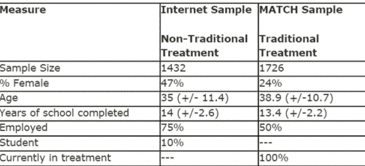Traditional substance abuse programs cannot always successfully serve every help seeking substance abuser. Roadblocks include logistical reasons, such as transportation, money to pay for treatments or childcare, as well as clinical reasons, such as the dynamics of treatment or group therapy (Gillaspy, Wright, Campbell, Stokes, & Adinoff, 2002; Saunders, Zygowicz, & D’Angelo, 2006). Online treatment programs potentially can expand the availability of care to people who cannot obtain traditional treatment. The effectiveness of these non-traditional treatments requires a better understanding. First, we need to learn more about the characteristics of those individuals who are willing to seek help via the Internet. This week’s DRAM discusses the clinical characteristics of treatment seekers using an online alcohol evaluation program and the implications for effective online interventions.
Lieberman (2005) designed a website to evaluate the clinical characteristics of those who sought help online. Using search terms like “alcohol abuse,” and “drinking problem,” 1,432 people searched for, registered at, and gave consent to participate in the study at the researcher’s website. Most registrants, 1,297 (90%), completed the evaluation. Participants responded to a number of scales, including the Alcohol Use Disorder Identification Test (AUDIT; Babor, De la Fluente, Saunders, & Grant, 1992). For a variety of measures, Lieberman compared the sample of online participants to participants in the Matching Alcoholism Treatments to Client Heterogeneity study (Miller & Tonigan, 1996; Project MATCH Research Group, 1997). Project MATCH evaluated 1,726 substance abusing or dependent adults from outpatient and aftercare programs. The MATCH sample represented people currently seeking treatment from traditional substance abuse programs.

Figure. Comparison of traditional and non-traditional help seekers. Click image to enlarge.
The Internet sample averaged 29.5 (+/- 22.4) drinks per week and 10.1 (+/- 5.6) drinks on the heaviest drinking day. The Internet sample averaged 17.3 (+/- 8.9) on the AUDIT, for which 8 or above indicates a problem with alcohol. Approximately 11% of the sample scored below an 8 on the AUDIT. Consequently, a portion of the Internet sample did not meet traditional criteria for an alcohol problem. This differs from the MATCH study, which required participants to satisfy criteria for alcohol abuse or dependence.
The Figure provides a side-by-side comparison of the Internet sample, which represents a potential non-traditional treatment group, to the MATCH sample, which represents a traditional treatment group. A higher rate of women accessed the website than participated in the MATCH study, but age and years of formal education were very similar. All MATCH participants were in treatment; Lieberman did not specify the portion of Internet users in treatment. Internet users had a high rate of employment as compared to the MATCH sample.
Compared to the MATCH sample, the Internet sample was not as uniformly disordered, and was more likely to be employed. These two factors suggest that the Internet sample might be healthier than the MATCH sample. Unfortunately, Lieberman did not inquire about Internet participants’ current or past alcohol treatment experience. So, it is impossible to determine whether the samples varied on this factor. It is important to note that the Internet sample is one of convenience; this limits our ability to generalize from this sample to a broad population of online treatment seekers. The participants also self-reported their previous experiences, a method of data collection subject to errors of memory, self presentation biases, and other factors.
Websites are accessible, private, demand less accountability and commitment than group therapy, and eliminate logistical reasons for not seeking traditional treatment (e.g., transit and childcare). Relatively high rates of participation by women suggest that online resources might facilitate help-seeking among underserved populations. Further, the absence of self-reported alcohol use disorders among the Internet population (i.e., 11%) might indicate that online treatment could be effective as an early intervention for those approaching, but not ready to commit to traditional alcohol treatment. Just as some people slowly acquire problems with alcohol, they also can acquire a habit of monitoring drinking patterns and seeking treatment slowly. Online treatments have the potential to be an effective strategy to provide systematized screening and personalized feedback to educate and raise awareness about potential alcohol problems.
—Leslie Bosworth
What do you think? Please use the comment link below to provide feedback on this article.
References
Babor, T. F., De la Fluente, J. R., Saunders, J., & Grant, M. (1992). The alcohol use disorders identification test: Guidelines for use in primary health care. Geneva, Switzerland: World Health Organization.
Gillaspy, J. A., Wright, A. R., Campbell, C., Stokes, S., & Adinoff, B. (2002). Group alliance and cohesion as predictors of drug and alcohol abuse treatment outcomes. Psychotherapy Research, 12(2).
Miller, W. R., & Tonigan, J. S. (1996). Assessing drinkers’ motivation for change: the Stages of Change Readiness and Treatment Eagerness Scale (SOCRATES). Psychology of Addictive Behaviors, 10, 81-89.
Project MATCH Research Group. (1997). Matching alcoholism treatments to client heterogeneity: Project MATCH posttreatment drinking outcomes. Journal of Studies on Alcohol, 58(1), 7-29.
Saunders, S. M., Zygowicz, K. M., & D’Angelo, B. R. (2006). Person-related and treatment-related barriers to alcohol treatment. Journal of Substance Abuse Treatment, 30(3), 261-270.




